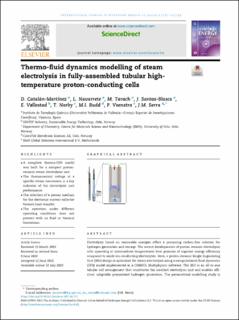| dc.contributor.author | Catalán-Martínez, D. | |
| dc.contributor.author | Navarrete, L. | |
| dc.contributor.author | Tarach, M. | |
| dc.contributor.author | Santos-Blasco, J. | |
| dc.contributor.author | Vøllestad, Einar | |
| dc.contributor.author | Norby, Truls | |
| dc.contributor.author | Budd, M.I. | |
| dc.contributor.author | Veenstra, P. | |
| dc.contributor.author | Serra, J.M. | |
| dc.date.accessioned | 2022-11-24T07:46:16Z | |
| dc.date.available | 2022-11-24T07:46:16Z | |
| dc.date.created | 2022-08-23T11:52:53Z | |
| dc.date.issued | 2022 | |
| dc.identifier.citation | International Journal of Hydrogen Energy. 2022, 47 (65), 27787-27799. | en_US |
| dc.identifier.issn | 0360-3199 | |
| dc.identifier.uri | https://hdl.handle.net/11250/3033769 | |
| dc.description.abstract | Electrolysis based on renewable energies offers a promising carbon-free solution for hydrogen generation and storage. The recent developments of proton ceramic electrolysis cells operating at intermediate temperatures bear promise of superior energy efficiency compared to oxide ion conducting electrolytes. Here, a proton ceramic Single Engineering Unit (SEU) design is optimized for steam electrolysis using a computational fluid dynamics (CFD) model implemented in a COMSOL Multiphysics software. The SEU is an all-in-one tubular cell arrangement that constitutes the smallest electrolysis unit and enables efficient, adaptable pressurized hydrogen generation. The parametrical modelling study is conducted for two adiabatic operation scenarios with distinct steam conversion rates and tested for multiple key parameters, namely internal and external chamber pressures and inlet stream temperature. The modelling results show that low steam conversions enable operation at higher current densities and that the thermoneutral voltage for a fixed steam conversion is highly sensitive to the process conditions and operation modes. The increment of the pressure of the generated hydrogen implies a reduced production rate at thermoneutral voltage, although it can be compensated with an enhanced steam pressure or a reduced inlet temperature. Additionally, the introduction of a porous medium as the SEU current collector in the steam chamber enhances heat transport within this chamber. The area specific resistance of the system determines the current density, enforcing an adaption of the area of the electrolyser to satisfy the target hydrogen production and energy efficiency. The resulting proposed SEU design and adapted operational parameters allow effective delivery of pressurized dry hydrogen for a wide range of conditions and applications. | en_US |
| dc.language.iso | eng | en_US |
| dc.publisher | Elsevier | en_US |
| dc.rights | Navngivelse 4.0 Internasjonal | * |
| dc.rights.uri | http://creativecommons.org/licenses/by/4.0/deed.no | * |
| dc.subject | Modelling | en_US |
| dc.subject | Water electrolysis | en_US |
| dc.subject | Tubular cell | en_US |
| dc.subject | CFD | en_US |
| dc.subject | Ceramic proton conductor | en_US |
| dc.title | Thermo-fluid dynamics modelling of steam electrolysis in fully-assembled tubular high-temperature proton-conducting cells | en_US |
| dc.title.alternative | Thermo-fluid dynamics modelling of steam electrolysis in fully-assembled tubular high-temperature proton-conducting cells | en_US |
| dc.type | Peer reviewed | en_US |
| dc.type | Journal article | en_US |
| dc.description.version | publishedVersion | en_US |
| dc.rights.holder | © 2022 The Authors. Published by Elsevier Ltd on behalf of Hydrogen Energy Publications LLC | en_US |
| dc.source.pagenumber | 27787-27799 | en_US |
| dc.source.volume | 47 | en_US |
| dc.source.journal | International Journal of Hydrogen Energy | en_US |
| dc.source.issue | 65 | en_US |
| dc.identifier.doi | 10.1016/j.ijhydene.2022.06.112 | |
| dc.identifier.cristin | 2045274 | |
| cristin.ispublished | true | |
| cristin.fulltext | original | |
| cristin.qualitycode | 1 | |

